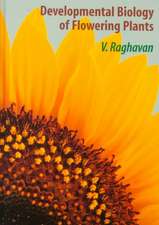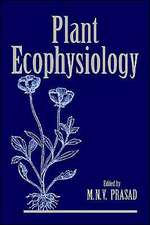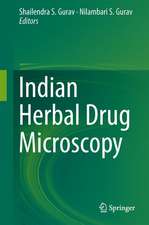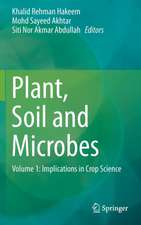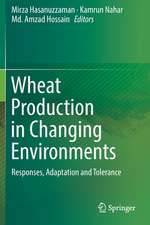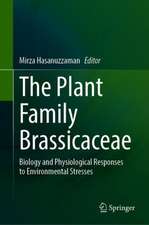Physiological Mechanisms and Adaptation Strategies in Plants Under Changing Environment: Volume 1
Editat de Parvaiz Ahmad, Mohd Rafiq Wanien Limba Engleză Hardback – 11 noi 2013
Physiological Mechanisms and AdaptationStrategies in Plants Under Changing Environment, Volume 1 discuss drought and temperature stresses and their mitigation through different means. This volume illuminates how plants that are bombarded by diverse and changing environmental stimuli, undergo appropriate physiological alterations that enable their survival. The information covered in the book is also useful in building apposite strategies to counter abiotic and biotic stresses in plants. Written by a diverse group of internationally renowned scholars, Physiological Mechanisms and Adaptation Strategies in Plants Under Changing Environment, Volume 1 is a concise yet comprehensive resource that will be beneficial for the researchers, students, environmentalists and soil scientists of this field.
| Toate formatele și edițiile | Preț | Express |
|---|---|---|
| Paperback (2) | 949.10 lei 6-8 săpt. | |
| Springer – 22 aug 2016 | 949.10 lei 6-8 săpt. | |
| Springer – 22 aug 2016 | 950.03 lei 6-8 săpt. | |
| Hardback (2) | 951.29 lei 6-8 săpt. | |
| Springer – 11 noi 2013 | 951.29 lei 6-8 săpt. | |
| Springer – 3 dec 2013 | 952.09 lei 6-8 săpt. |
Preț: 951.29 lei
Preț vechi: 1160.10 lei
-18% Nou
Puncte Express: 1427
Preț estimativ în valută:
182.02€ • 190.73$ • 150.48£
182.02€ • 190.73$ • 150.48£
Carte tipărită la comandă
Livrare economică 11-25 aprilie
Preluare comenzi: 021 569.72.76
Specificații
ISBN-13: 9781461485902
ISBN-10: 1461485908
Pagini: 392
Ilustrații: XV, 376 p. 70 illus., 44 illus. in color.
Dimensiuni: 155 x 235 x 27 mm
Greutate: 0.61 kg
Ediția:2014
Editura: Springer
Colecția Springer
Locul publicării:New York, NY, United States
ISBN-10: 1461485908
Pagini: 392
Ilustrații: XV, 376 p. 70 illus., 44 illus. in color.
Dimensiuni: 155 x 235 x 27 mm
Greutate: 0.61 kg
Ediția:2014
Editura: Springer
Colecția Springer
Locul publicării:New York, NY, United States
Public țintă
ResearchCuprins
Mechanisms and Adaptation of Plants to Environmental Stresses: A Case of Woody Species.- Drought Tolerance: Roles of Organic Osmolytes, Growth Regulators and Mineral Nutrients.- Influencing the Product Quality by Applying Drought Stress during the Cultivation of Medicinal Plants.- Water Scarcity and Water Stress in Agriculture.- Biotechnology for Drought and Salinity Tolerance of Crops.- Effect of Salinity on Plants and the Role of Arbuscular Mycorrhizal Fungi and Plant Growth Promoting Rhizobacteria in Alleviation of Salt Stress.- Cash Crop Halophytes-The Ecologically and Economically Sustainable Use of Naturally Salt Resistant Plants in the Context of Global Changes.- Effect of Heat Stress on Growth and Crop Yield of Wheat (Triticum aestivum).- Low Temperature Stress in Plants: An Overview of Roles of Cryoprotectants in Defense.- Lignins and Abiotic Stress: An Overview.- Humic Substances and Plant Defense Metabolism.- Mitochondrial Respiration: Involvement of the Alternative Respiratory Pathway and Residual Respiration in Abiotic Stress Responses.
Recenzii
From the reviews:
“The presentation of the topics is consistent throughout the book. A ‘Conclusions and Future Prospects’ section in each chapter encapsulates the contents of the chapter and discusses future areas of investigation. The depth of the material presented makes the work appropriate for graduate students in plant physiology courses, as either a textbook or supplementary reading. Summing Up: Recommended. Graduate students and researchers/faculty.” (J. L. Hatfield, Choice, Vol. 51 (9), May, 2014)
“The presentation of the topics is consistent throughout the book. A ‘Conclusions and Future Prospects’ section in each chapter encapsulates the contents of the chapter and discusses future areas of investigation. The depth of the material presented makes the work appropriate for graduate students in plant physiology courses, as either a textbook or supplementary reading. Summing Up: Recommended. Graduate students and researchers/faculty.” (J. L. Hatfield, Choice, Vol. 51 (9), May, 2014)
Notă biografică
Dr. Parvaiz Ahmad
Department of Botany, Sri Pratap College, Srinagar, Jammu and Kashmir, India
Dr. Mohd Rafiq Wani
Department of Botany, Govt. Degree College (Boys), Anantnag, Jammu and Kashmir, India
Department of Botany, Sri Pratap College, Srinagar, Jammu and Kashmir, India
Dr. Mohd Rafiq Wani
Department of Botany, Govt. Degree College (Boys), Anantnag, Jammu and Kashmir, India
Textul de pe ultima copertă
The global population is growing at an alarming rate and is anticipated to reach about 9.6 billion by the end of 2050. Addressing the problem of food scarcity for budding population vis-à-vis environmental changes is the main challenge plant biologists face in the contemporary era. Plant growth and productivity are scarce in many areas of the world due to a wide range of environmental stresses. The productive land is dwindling progressively by various natural and anthropogenic means that lead to enormous crop losses worldwide. Plants often experience these stresses and have the ability to withstand them. However, when the stress exceeds the normal tolerance level, plants accumulate organic osmolytes, osmoprotectants, cryoprotectants and antioxidant enzymes, which helps them tolerate these stresses and assist in their acclimatization towards the particular ambiance needed for maintaining their growth and development.
Physiological Mechanisms and AdaptationStrategies in Plants Under Changing Environment, Volume 1 discusses drought and temperature stresses and their mitigation through different means. This volume illuminates how plants that are bombarded by diverse and changing environmental stimuli undergo appropriate physiological alterations that enable their survival. The information covered in the book is also useful in building apposite strategies to counter abiotic and biotic stresses in plants. Written by a diverse group of internationally renowned scholars, Physiological Mechanisms and Adaptation Strategies in Plants Under Changing Environment, Volume 1 is a concise yet comprehensive resource that will be beneficial for the researchers, students, environmentalists and soil scientists of this field.
Physiological Mechanisms and AdaptationStrategies in Plants Under Changing Environment, Volume 1 discusses drought and temperature stresses and their mitigation through different means. This volume illuminates how plants that are bombarded by diverse and changing environmental stimuli undergo appropriate physiological alterations that enable their survival. The information covered in the book is also useful in building apposite strategies to counter abiotic and biotic stresses in plants. Written by a diverse group of internationally renowned scholars, Physiological Mechanisms and Adaptation Strategies in Plants Under Changing Environment, Volume 1 is a concise yet comprehensive resource that will be beneficial for the researchers, students, environmentalists and soil scientists of this field.
Caracteristici
Written by a diverse group of internationally known scholars Latest results, techniques, and methods of plant mechanism and adaptation to stress research Climate change discussion related to this important subject?






